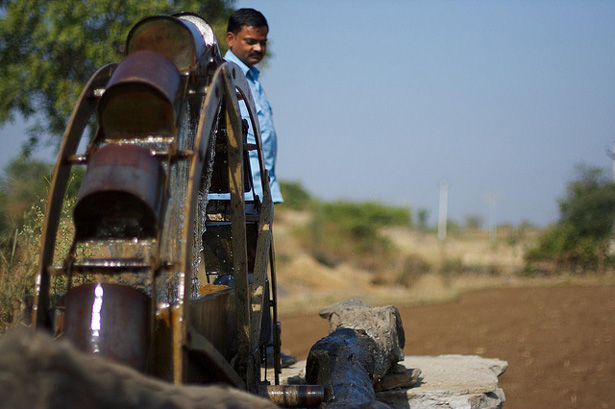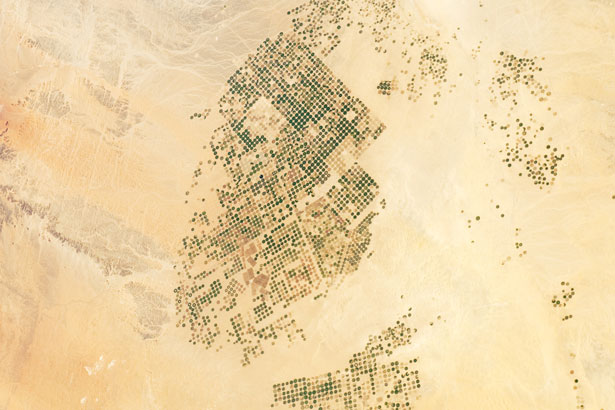-
‘National Geographic’ Reports on “Water Grabbers” From Mali to India
March 26, 2013 By Carolyn Lamere
Much ink has been spilled on the growing trend of global land grabs – land purchased en masse in developing countries like Ethiopia by foreigners mainly for agricultural export. But along with land, investors often also gain the right to use local water, and sometimes with little consideration for local livelihoods. Fred Pearce recently looked into these “water grabs” in a series for National Geographic.
In Water Grabbers: A Global Rush on Freshwater, Pearce outlines water scarcity across two continents and four cultures, focusing on Mali, Saudi Arabia, Ethiopia, and India. In each of these countries, Pearce finds unsustainable water use, from farming in the Arabian desert and water “grabs” in Mali and Ethiopia to farmers giving up their plows and selling water to nearby factories in India.
Mismanagement Driving Scarcity
Aquifer levels are falling all around the world, from the United States to the North China Plain. “Falling groundwater levels are the bellwethers of the unsustainability of our water use,” Brian Richter of The Nature Conservancy tells Pearce in one article. “We’re raiding our savings accounts with no payback plan.”
Much of this scarcity is caused by mismanagement of existing resources rather than climate changes.
Villagers near textile factories in southern India are “farming water” instead of crops, writes Pearce. They sell water from their reservoirs to dyeing and bleaching factories. While this provides a stable income now, it is unsustainable in the long run. One woman told Pearce that “every day the water is reducing. We drilled two new boreholes a few weeks ago and one has already failed.”
Stories like this are playing out all across India – and around the world. Forty-six cubic miles of water (50,198 gallons) are pumped annually out of India’s groundwater reserves and only 26 cubic miles are naturally replenished. The United States faces a 7.8 cubic mile deficit every year, and China loses 4.2 cubic miles annually.
In Saudi Arabia, the government began pumping from its massive underground aquifers 30 years ago, intensively irrigating desert to turn it into farmland. Some aquifers – like those in India – are replenishable, but those on the Arabian Peninsula were filled tens of thousands of years ago, when the geography of the area was very different. Shifting geology now cuts these aquifers off from the surface while the changing climate has sapped the region of most its above-ground moisture. “Virtually none of it is replaced by the rains, because there effectively are no rains,” Pearce reports.
The series includes striking photographs of Saudi crop circles, showing the contrast between lush, cultivated grain fields and the surrounding area. But now, “the water is running out,” writes Pearce. While it’s impossible to know exactly how much water is left in the aquifers, experts suggest that four-fifths of it is gone.
In response, the government is revising its agricultural policy. Farmers who were once paid five times the market price for grains will be required to stop growing wheat by 2016. This has not, however, stopped Saudi Arabia’s drive for food independence, merely shifted its focus.
Saudi companies are now purchasing or leasing agricultural land abroad, including in parts of Africa. Pearce traveled to Ethiopia and the headwaters of the Nile to investigate the effects of this foreign direct investment. Agricultural companies like Saudi Star are purchasing land in the area, and using up local water. He reports that “unrest is brewing. Locals say the Saudis want their water.” These are not idle words – not long after Pearce left one village, a group of people attacked a company camp, angry that their livelihoods were being threatened by foreign farmers.
Pearce reports on a similar situation in Mali. Though so far they have luckily escaped the water-related violence seen in Ethiopia, Daouda Sanankoua, mayor of Deboye, a district where foreign agricultural firms have begun investing, said he feels threatened by the presence of external investors.
“Everything here depends on the water,” Sanankoua told Pearce. “But the government is taking our water. They are giving it to foreign farmers. They don’t even ask us.”
A Coming Crisis?
Apart from Mali, whose stability issues are quite apart from natural resource management, the regions profiled in the series have yet to hit a full-on crisis point, but the general tenor is that catastrophe is looming – the water will run out.
In addition, population and consumption levels are expected to grow in each. The population of Saudi Arabia has increased almost nine-fold since 1950 and India rose from 371 million to 1.3 billion over the same period. Growing middle classes mean greater demand for water per person. Livestock for meat requires more water than grain and energy production and industry also require vast quantities of water. The total fertility rates of Saudi Arabia, Mali, Ethiopia, and India are all above replacement level, ranging from 2.73 children per woman (India) to 6.46 (Mali).
As global population grows from seven billion people to more than nine billion by 2050, more regions will experience this kind of stress. Even without factoring in future changes, which can be somewhat mitigated by technological and cultural shifts, the current patterns of water use described in the series are not sustainable. In many parts of the world, groundwater is simply being used more quickly than it naturally replenishes – and often in places where agriculture is the primary means for earning a living. As one Indian water farmer said, “it’s risk-free, while the water lasts.” But what will happen when – and not if – the water runs out?
Sources: National Geographic, The New York Times, UN Population Projections.
Photo Credit: Well in Udaipur, India, courtesy of flickr user Milo & Silvia in the world; Saudi Arabian center-pivot irrigation, courtesy of NASA.
Topics: Africa, Asia, climate change, conflict, consumption, environment, environmental health, Ethiopia, featured, India, land, livelihoods, Mali, media, On the Beat, population, Saudi Arabia, security, water
 A Publication of the Stimson Center.
A Publication of the Stimson Center.




